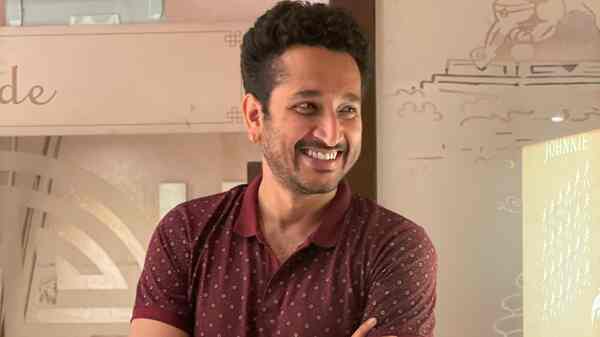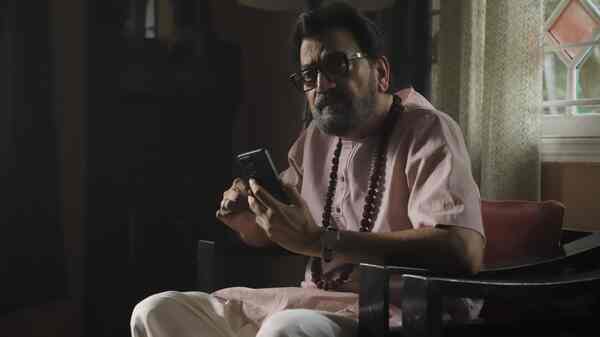Nikosh Chhaya director Parambrata Chatterjee: One can be totally rational and still believe in ghosts and spirits | Exclusive
Nikosh Chhaya director Parambrata Chatterjee highlights the challenges of making authentic horror content and addresses the stigma associated with the genre.

Last Updated: 07.23 PM, Oct 30, 2024
Parambrata Chatterjee is all set with the second adventure of occult master Bhaduri Moshai. With Chiranjeet Chakraborty as protagonist and Surangana Bandyopadhyay, Gaurav Chakrabarty, Anindita Bose, Anujoy Chattopadhyay, and others in the key characters, his Nikosh Chhaya will start streaming on Hoichoi from October 31. By his admission, Parambrata is an ardent follower of the genre. "I can watch back-to-back horror films all day," he said. This perhaps has encouraged him to explore the genre in an industry that has generally 'sugarcoated' horror with comedy and romance.
Parambrata's first effort of Bhaduri Moshai adventure, Parnashavarir Shaap, was dropped last year during the same time and received positive reviews from viewers and critics, alike. It took no time to get a second-season renewal. Before the release of Nikosh Chhaya, the director talked about his love for horror as a genre and many more. Read on...
We don’t have many really scary Bengali horror films in our industry, and their success stories are also limited. Why did you choose such a genre?
Not many people ventured into scary horror films apart from a few like Kuheli, which I watched in my childhood. It has been my very favourite genre always. But my love for it intensified four to five years ago. I always felt that as opposed to the West, our subcontinent has so much diversity in terms of customs and rituals that it could offer brilliant supernatural horror stories. In fact, if you even consider one religion, there is an array of ways people practice the rituals. Paranormal stories are often about good and evil. In the West, this idea of good and evil is very black and white. Here, it is more layered.
So last year, I told the platform that I wanted to make something like this and their immediate reaction was, “Ekhane to keu erokom banaye na re (but nobody makes such stuff here).” I think a lack of imagination is one of the reasons why this genre remained unexplored. But you need more. You will have to enjoy the spookiness. You’ll have to be intrigued by it. You’ll have to believe in supernatural elements. It doesn’t mean you’ll have to be superstitious. You will have to enjoy the horror. Also, a horror film is not just about jump cuts. It is also about emotions. You’ll have to be intrigued by it. So, I did not think about the success stories. People love horror. That’s why they follow a strange sound from the next room. That’s what I wanted to explore.

What are the primary challenges of making horror content?
I also feel that one of the reasons why we don’t have many horror films is because they have been seen as a lesser genre. All these bhoot, pret, and pishach have been looked down upon. There has been a lack of awareness and a level of, I would say, classicism. In our country 80% of the population are believers. What’s the point of being in denial? We need to embrace reality.
We usually avoid Bibhatsa Rasa and Bhayanaka Rasa. These are the basic cruxes of horror. We usually access the other Rasas like Shringar and Hasya more easily. I wanted to create that atmosphere of horror which is filled with Bibhatsa and Bhayanaka Rasa.
Traditionally, horror films need a lot of VFX and superior technical things. How did you manage that in a cash-strapped industry in Bengal?
Yes, horror films demand a certain level of budget for VFX, etc. However, if one is smart enough one can avoid a part of it. In Parnashavarir Shaap, we have a scene where a possessed Surangana has her hand inside a dead animal. We could have resorted solely to VFX. However, I have a solid Production team. Riddhi Basak told me, “What if we make it.” The team did make it and then touched it up with VFX. This time too, we have this character Genu. You will see the detailing in the makeup and everything else.
Also, horror films, occult masters, etc, involve a level of superstitions. How did you address this while making Bhaduri Moshai?
This is a critical question. Once I enter this universe there is no looking back. I make what it demands. You cannot be in two minds that you will show some and hold other things back. You have to go all out. We have to take it head on and you’ll have to believe in the supernatural. And then you will have to show the good and evil. I am a believer. I am not a religious person but I believe in god. I don’t believe in institutionalised religion. Similarly, I believe in ghosts and spirits.
Isn’t there a conflict between being rational and a believer?
I don’t think so. There is no conflict. This is how we were told to perceive rational behaviour. The legacy of our Renaissance taught us to be rational without faith. But outside Bengal, in North India, and even in Bangladesh, we see a different picture. A person can be fiercely liberal even having faith in their Gods. They are not mutually exclusive. I remember while shooting Bhuban Majhi in Kushtia, Kalikada (Kalika Prasad Bhattacharya) pointed this out to me. You don’t need to be an atheist to be secular. You will have to have an open mind. So yes, I believe in God and ghosts.
We have seen you taking part in the recent protest movement after the heinous RG Kar incident. What’s your take on this movement?
The reason the movement became incredibly big is largely because of its sheer shock value. An on-duty doctor was brutalised and killed in a hospital – a place that we expect to be the safest for all. And then, people also profoundly joined the movement because, for the longest time, there was no political side taking in the protest. Many other movements, like the farmers’ protest and, the NRC-CAA movement, were big but those movements also had a clear political stand. This was more of a social movement that later started questioning the administration and holding it accountable. And that was great. Holding the administration accountable is one of the fundamental choices in a democracy. The doctors and civil society did not let it be hijacked by any political party for the longest time. In fact, state dispensation also tried to bring political colours and that is just because for them it was easier to tackle political opposition than dealing with a regular mass movement.
However, this enourmous protest brought out the murky reality of corruption and syndicates. The doctors proved that voices can be raised, and the system can be challenged.
That brings us to the alleged 'threat culture' in the Bengali entertainment industry. The Directors’ Association of Eastern India (DAEI) sued the president of the Federation of Cine Technicians and Workers of Eastern India Swarup Biswas. There are allegations of bullying. However, a large part of it was known by everybody close to the industry. What took you so long?
If one is wronged for 10 years that does not mean they can’t protest on the 11th year. The directors right now have a long-term plan to combat the existing problems. First things first, our movement is definitely not against the technicians. After working in this industry for decades almost all of us share a special bond with the technicians. We work with them day in and day out. Many of them know us better than our friends and family members. They know what I eat, how my diet plan changed over the years, what is my skin tone and type and so on. We know about their family members, their children and their education, and so on. So our movement is not against them by any means.
We would not have started this unless we were pushed to the wall. People who claim to safeguard the interests of the technicians are lying. Threat culture engulfed the Federation because of them. They have crossed every limit so much that they started thinking that they are the court, police, and authority. By doing this, they are engaging in completely unlawful business. This is one of the reasons why our industry was pushed to corners. We got together to salvage our industry.

 Premium
Premium